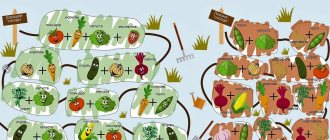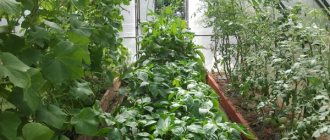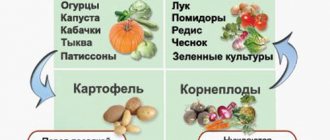The main condition for a good harvest of cucumbers is increased humidity and temperature stability. Such conditions are difficult to provide in open ground, and therefore this crop is often grown in a greenhouse.
Caring for cultivated plants in a greenhouse requires a lot of effort, so it would be irrational to leave empty space. And here the question arises, what can be planted with cucumbers in a greenhouse. It is worth choosing crops that require similar care. By choosing the right neighbors, you can get a bountiful harvest, doing less work, and also saving space.
Why some crops cannot be planted next to cucumbers
The space on the site for installing a greenhouse is limited, so you need to select neighbors very carefully. For many decades, people have been studying the interaction between neighboring plants. Proper placement of crops helps protect them from diseases and pests, as well as increase productivity. And all this without the constant application of mineral fertilizers, which saves money and makes the products more environmentally friendly.
Plants create favorable conditions for each other for growth, healing the soil, feeding it with useful substances, in particular nitrogen. Other plants loosen the soil with their roots, prevent harmful weeds from growing, and prevent soil depletion and weathering.
Some plants attract pollinating insects for various crops in the garden, as well as birds and pest-killing insects. Other plants drive away rodents and harmful insects that spoil the crop.
It is also necessary to think through a planting plan because different crops require special growing conditions. What is good for one may be bad for another. Cucumbers require moist air and constant maintenance of moist soil, infrequent but plentiful. These conditions are not suitable for many garden plants. For example, it is difficult for nightshades (potatoes) to grow next to cucumbers; they become depressed and weak. High temperature and humidity are not good for tomatoes. However, some gardeners successfully grow tomatoes with cucumbers. An example will be the heroine of the video posted at the end of the article.
Features of growing cucumbers
Cucumbers need to be planted on fertile, light and warm soil that does not become waterlogged and contains many nutrients. In the fall, when preparing the bed for the next year, rotted manure or compost is added at the rate of 5-6 kg per 1 sq.m. When decomposition processes begin, heat is released and the bed is saturated with nutrients. And cucumber leaves absorb carbon dioxide released during the decomposition of manure.
Every morning, the cucumbers are watered with warm, settled water. They have a superficial root system, which is also fragile and delicate. Lack of oxygen and damage lead to their death, or damage to spider mites and diseases. Therefore, the soil must be kept loose and moderately moist. This option is not suitable for most plants.
Cucumbers are picky about temperature.
When it drops to 10 degrees, the leaves turn yellow and growth stops. When it drops to 5 degrees and below, the leaves fall off and are affected by powdery mildew. And when the air temperature rises, the pollen in the flowers sticks together, they are not pollinated, and the flowers fall off.
It is best to grow cucumbers vertically; to do this, they are tied to a trellis. This makes them easier to care for and reduces the risk of disease and pest damage.
This growing principle is not suitable for all plants. Not all crops are suitable for growing together with cucumbers for the following reasons:
- Spreading mustaches of cucumbers can oppress neighbors in the garden.
- Also, on the contrary, neighboring plants may have too strong a root system, which will not allow the cucumber plant to develop.
- Other plants will draw all the moisture from the ground, which creates extremely unfavorable conditions for cucumbers.
- It is not recommended to grow plants belonging to the same family nearby, as they will “argue” with each other.
- Neighbors can consume a lot of nitrogen, which is necessary for the growth and development of cucumbers.
What conditions does the cucumber plant like?
Cucumbers are greenhouse plants. Summer residents mainly grow cucumbers in a polycarbonate greenhouse. The question of what other crops can be planted in the greenhouse next to them depends on what conditions the cucumber plants prefer.
Cucumbers love heat very much. They also prefer good lighting. Variability of weather conditions and temperature fluctuations mainly frighten them. The greenhouse should be fairly humid; they prefer a humid climate. Frequent watering for cucumbers in a greenhouse is required. Cucumbers also grow well only on fertile soil, which must be periodically loosened and fertilized. Humus and manure have a good effect on them, but an excess of nitrogen impairs fruiting.
Therefore, you can plant next to them only those plants that have similar needs, so that they are easier to care for . This is the only way to achieve a good harvest. It is worth noting that not all crops get along well with cucumbers. Some only prevent them from growing.
What can you plant in a greenhouse next to cucumbers?
Before you organize your garden, look at which crops get along well next to cucumbers, which will be good predecessors and successors after green vegetables.
Cucumbers get along well with the following crops.
Eggplant
Crops have similar requirements for watering and care. When growing them together, you need to provide the cucumbers with supports for the vines in time, then they will not oppress each other. If you plant eggplants in a greenhouse together with cucumbers, then plant the eggplants in a sunny place first, since the wide leaves of cucumbers can shade them.
Will bell peppers grow along with cucumbers?
This is another advantageous neighborhood. Peppers like the same growing conditions as cucumbers. They do not tolerate drafts, dry soils and dry, hot air. Just tie up the vines so as not to shade the nightshade crop. Cabbage and peppers are also excellent predecessors for garden beds in front of cucumbers.
Here's what you can plant in a greenhouse with cucumbers
Zucchini
Both cultures do not oppress each other. Their proximity is not dangerous, since they do not inter-pollinate, although they are relatives. Both plants love water and light. But make sure that the large zucchini leaves do not shade the cucumber leaves.
Corn and cucumbers
For large garden plots this is one of the best combinations. Corn serves as a curtain for cucumbers, protecting them from the scorching sun and drafts. The root systems differ: in the first they go deep, in the greenfinch they are superficial. Plus, the vines of cucumbers curl perfectly along the stems of a strong neighbor.
Neighborhood of cucumber and onion
Both plants are friendly to each other. The meadow is also an excellent predecessor for cucumbers. But it is better not to plant onions immediately after cucumbers; first grow legumes in this place.
Is it possible to plant garlic next to cucumbers?
This neighbor is great for cucumbers. It repels pests.
Peas and beans near cucumbers
Legumes saturate the soil with nutrients, especially nitrogen. Therefore, if they grow nearby or even in the middle of the garden bed, the yield of cucumbers increases.
Chives
If you plant both crops side by side, cucumbers will not suffer from powdery mildew.
Will cucumbers grow next to carrots?
These plants in neighboring beds do not negatively affect each other in any way.
Is it possible to plant dill with cucumbers?
This aromatic herb is an exception among spicy plants; it is not advisable to plant others. It is useful to grow wormwood, thyme and thyme nearby; they repel pests such as slugs that eat young fruits.
Cucumbers also work well with radishes, different varieties of cabbage and broccoli, mustard and spinach.
Useful articles:
Growing radishes
How to grow cabbage
Growing and caring for Broccoli
When to sow and when to bury mustard in the ground
Many gardeners are concerned about whether it is possible to plant different varieties of cucumbers side by side . There is no definite answer, since if the varieties are pollinated, then as a result of proximity they can be cross-pollinated. If the varieties are self-pollinating, then nothing bad should happen. But even in the first case this is not catastrophic. It all depends on whether you will use grown seeds or plant purchased ones every year. In case of cross-pollination, fruits can receive varietal characteristics of each other. For home use this is not important .
Basic rules of crop rotation
Proper rotation of crops is the key to high productivity. There are good and bad predecessors for cucumbers.
Nightshades and legumes are considered good predecessors. The only exception is beans. Speaking of nightshades, it is worth highlighting potatoes and tomatoes. Cucumbers also grow well after onions, of any variety. They can be successfully grown after cauliflower or white cabbage and many root vegetables. Carrots and beans cannot be included here, as they are susceptible to white rot (this disease is fatal to the cucumber crop).
Beetroot is a neutral precursor. Also, without any problems, the crop can be planted in the garden bed where radishes were previously collected.
Expert opinion
Stanislav Pavlovich
Gardener with 17 years of experience and our expert
Ask a Question
The pumpkin family is considered the worst predecessors. It is not recommended to grow cucumbers in the place where pumpkin, zucchini or squash previously grew; these crops are susceptible to identical diseases.
To prevent depletion of soil in the garden plot, it is necessary to organize crop rotation. Cultures must be alternated. Fertilizing the soil alone will not do it. Vegetables, fruits or herbs are rotated based on the nutrient dependency of each individual crop.
Cucumbers, like their predecessors, are demanding on soil and fertilizers. After them, you can plant potatoes, turnips, radishes, carrots, beets or celery, since these plants are not picky about the composition of the soil.
Important! Planting of cucumbers is carried out with preliminary fertilization of the soil with mineral compounds and organic fertilizers, regardless of who the crop will grow next to.
What not to plant next to cucumbers
And although it is believed that cucumbers do not have an unfortunate neighborhood, there are nevertheless a number of plants that should not be planted next to cucumbers. These include:
- basil, arugula and other aromatic, fragrant herbs. They oppress cucumbers.
- fennel _ It has a powerful root system that grows strongly and draws all the moisture and nutrients from the soil.
- tomatoes . Nightshades take the same nutrients from the soil that cucumbers need. Plus they require completely different growing conditions. Next to cucumbers, they will simply drown and will constantly get sick. However, there is no clear opinion among gardeners on this matter. If you maintain distance and agricultural technology, then tomatoes and cucumbers can coexist in the same greenhouse.
- potato. The situation with it is the same as with tomatoes. Plus, cucumbers and potatoes are mutually inhibiting plants. Potatoes take up all the water and nutrients and shade the cucumbers. In addition, they share common pests and diseases.
- strawberry . Plants require different care; from frequent watering, garden strawberries will quickly drown and begin to hurt. But cucumbers do not like very sunny places, their leaves turn yellow, and productivity decreases.
- Watermelons and melons belong to the same family as cucumbers. Therefore, in order to avoid cross-pollination, it is undesirable to plant them next to each other. Plants will oppress each other. The leaves of melon and watermelon are much larger than cucumber leaves, so they will shade them.
Another opinion about the proximity of zucchini and cucumbers in the same greenhouse
According to standard recommendations, these plants can be planted together, since they develop in the same conditions. Most believe that the main problem of the proximity of crops is that large zucchini leaves can shade cucumber vines. If this problem is solved by proper planning of the beds and applying a sufficient amount of fertilizer for both crops, then nothing will interfere with the growth of both species.
But in practice, many face a number of problems. The first is diseases. When grown together, both plants are often affected by powdery mildew and spread very quickly. The second nuance characteristic of bee-pollinated varieties is that the pollination process is disrupted. The harvest that grows is frail, and sometimes there is none at all. In addition, zucchini has a highly developed root system, and it can inhibit cucumbers.
Zoning and partitions
Zoning a garden plot is an important part of its organization. If the beds are placed chaotically, then not all crops will receive the necessary care. Planting should be done in a certain order and with a convenient location of the water source. This will help maintain enthusiasm for caring for the area and prevent it from developing into a duty and punishment.
Significant points in organizing the site are the following:
- Zone the beds according to the rule: the more care required, the closer they need to be. The same applies to greenhouses. If you feel unwell or don’t want to, the plants will be at hand, and you won’t have to drag heavy buckets and a hose to water the beds.
The same system works for mixed beds. Plant things that need frequent watering closer together. If you combine cucumbers with anything else, then place the cucumbers closer.
- Look where the shadow falls. Partial shade is suitable for cucumbers; they will produce a little less yield, but they will not get sick. That's why they are planted next to sunflowers and corn.
- Separate cucumber beds with borders, flowers or greenery. Onions, garlic, marigolds, dill and thyme are suitable for this. This will help limit the decaying vines of cucumbers and preserve the fruits from damage while walking along the paths. Broken brick, tiles, slate, large pebbles, even empty bottles are suitable for creating a border.
- Place natural hedges on the east and south sides. This will help protect the cucumbers from the hot sun during the heat of the day.
Another condition for successfully growing cucumbers is the installation of a modern irrigation system. This will make it easier to irrigate on time when you are unable to do it yourself.
Pepper and eggplant next to cucumber
It is allowed to plant peppers and eggplants together in a greenhouse with cucumbers. It should be borne in mind that peppers and eggplants prefer nitrogen-containing fertilizers, and cucumbers prefer organic fertilizers.
It is recommended to place plants in such a way that one crop does not shade another. For example:
- place cucumbers on the central ridge;
- we plant eggplants on the left;
- on the right are peppers.
To prevent cross-pollination, only one type of pepper is grown in the greenhouse - sweet or bitter.
Conclusion
We told you what you can plant in a greenhouse with cucumbers. The culture gets along well with many plants, so organizing beds for cucumbers is not difficult. If you don’t plant a number of crops nearby, you will get a bountiful and tasty harvest.
Erets are excellent predecessors for the beds in front of cucumbers.
Here's what you can plant in a greenhouse with cucumbers
Zucchini
Both cultures do not oppress each other. Their proximity is not dangerous, since they do not inter-pollinate, although they are relatives. Both plants love water and light. But make sure that the large zucchini leaves do not shade the cucumber leaves.
Corn and cucumbers
For large garden plots this is one of the best combinations. Corn serves as a curtain for cucumbers, protecting them from the scorching sun and drafts. The root systems differ: in the first they go deep, in the greenfinch they are superficial. Plus, the vines of cucumbers curl perfectly along the stems of a strong neighbor.
Neighborhood of cucumber and onion
Both plants are friendly to each other. The meadow is also an excellent predecessor for cucumbers. But it is better not to plant onions immediately after cucumbers; first grow legumes in this place.
Is it possible to plant garlic next to cucumbers?
This neighbor is great for cucumbers. It repels pests.
Peas and beans near cucumbers
Legumes saturate the soil with nutrients, especially nitrogen. Therefore, if they grow nearby or even in the middle of the garden bed, the yield of cucumbers increases.
Chives
If you plant both crops side by side, cucumbers will not suffer from powdery mildew.
Will cucumbers grow next to carrots?
These plants in neighboring beds do not negatively affect each other in any way.
Is it possible to plant dill with cucumbers?
This aromatic herb is an exception among spicy plants; it is not advisable to plant others. It is useful to grow wormwood, thyme and thyme nearby; they repel pests such as slugs that eat young fruits.
Cucumbers also work well with radishes, different varieties of cabbage and broccoli, mustard and spinach.
Useful articles:
Growing radishes
How to grow cabbage
Growing and caring for Broccoli
When to sow and when to bury mustard in the ground
Many gardeners are concerned about whether it is possible to plant different varieties of cucumbers side by side . There is no definite answer, since if the varieties are pollinated, then as a result of proximity they can be cross-pollinated. If the varieties are self-pollinating, then nothing bad should happen. But even in the first case this is not catastrophic. It all depends on whether you will use grown seeds or plant purchased ones every year. In case of cross-pollination, fruits can receive varietal characteristics of each other. For home use this is not important .
Good neighborhood
Cucumbers grow in almost every summer cottage. To obtain a useful harvest of good quality, gardeners should know which neighbors are considered the most successful for the crop and why.
Corn
This plant does not deprive cucumbers of the nutrients they need and protects them from gusty winds. Cucumber vines can be fixed to its stems; in such conditions they will feel comfortable, and the yield will increase by 20%.
Onion
Cucumbers have an excellent relationship with onions. Thanks to phytoncides, it will protect cucumbers from many diseases and pests.
Garlic
Garlic gets along well with cucumbers. But it is better to plant it between the beds. This way it will promote the growth of greenery and repel annoying pests.
Cabbage
The optimal solution for the neighborhood. In this crop, the root penetrates deep into the soil, which helps it draw moisture from the ground. For its growth, the minerals required for cucumbers are not used.
It can be placed either on an adjacent plot or interspersing crops. The main thing is to keep your distance so that the plants have enough space to fully develop.
Beet
Beets will normally coexist with cucumbers. But it is advisable to give preference to early varieties. While the cucumber fruits are ripening, the root vegetables can already be harvested. Otherwise, the cucumber shoots will begin to take away the sunlight required for the beets.
Peas and beans
The roots of these legumes are a source of nitrogen compounds, which cucumbers really need. It is recommended to leave the stems of these crops in the soil even after harvesting.
Radish
This crop is not demanding of heat, but it does need a lot of moisture. Because of this, radishes can be planted along a bed with cucumbers without any doubt. This close proximity will not prevent the growth of vines and will ensure the harvest of the crop itself.
What not to plant next to cucumbers
And although it is believed that cucumbers do not have an unfortunate neighborhood, there are nevertheless a number of plants that should not be planted next to cucumbers. These include:
- basil, arugula and other aromatic, fragrant herbs. They oppress cucumbers.
- fennel _ It has a powerful root system that grows strongly and draws all the moisture and nutrients from the soil.
- tomatoes . Nightshades take the same nutrients from the soil that cucumbers need. Plus they require completely different growing conditions. Next to cucumbers, they will simply drown and will constantly get sick. However, there is no clear opinion among gardeners on this matter. If you maintain distance and agricultural technology, then tomatoes and cucumbers can coexist in the same greenhouse.
- potato . The situation with it is the same as with tomatoes. Plus, cucumbers and potatoes are mutually inhibiting plants. Potatoes take up all the water and nutrients and shade the cucumbers. In addition, they share common pests and diseases.
- strawberry . Plants require different care; from frequent watering, garden strawberries will quickly drown and begin to hurt. But cucumbers do not like very sunny places, their leaves turn yellow, and productivity decreases.
- Watermelons and melons belong to the same family as cucumbers. Therefore, in order to avoid cross-pollination, it is undesirable to plant them next to each other. Plants will oppress each other. The leaves of melon and watermelon are much larger than cucumber leaves, so they will shade them.
Optimal growing conditions
When growing melon in the garden, it is better to place it in the sunny parts of the plot; you should also pay attention to the following recommendations:
- Before planting, you should plan out the areas where the melons will be located;
- When planning, it is important to remember the compatibility of cultures;
- there must be at least 80 cm between holes;
- When planting seedlings, you should be extremely careful with the roots of the plant;
- It is worth pouring sand around the shoot to prevent “black leg”;
- it is necessary to periodically loosen the soil, remove weeds, water and hill up the melon beds;
- When watering plants, you should prevent water from getting on the foliage and shoots of the plant;
- We must not forget about the formation of the bush: pinching, removing unnecessary ovaries;
- It is important to fertilize regularly.
In the open ground
The ground there should warm up well and be protected from gusts of cold wind. In addition, you can choose southern slopes. There, the melon crop will ripen faster and be more resistant to disease.
Melon prefers light, sandy and sandy loam soil that has a neutral pH.
On a note! You can achieve a neutral pH on your own: by acidifying alkaline soil or alkalizing acidic soil.
This melon crop tolerates drought and soil salinity well. However, high humidity and acidification of the soil have a detrimental effect on it. In the central zone of the Russian Federation, the seedling method of growing melon is recommended. The crop is planted in open ground in the last days of May.
One bush can ripen 2-10 fruits. The ripening period lasts from 2-6 months.
In the greenhouse
When growing melon in a greenhouse, you should remember about plant compatibility. Not every gardener has several greenhouses for separate planting of crops. But the microclimate requirements of plants must be taken into account. So it is not allowed to plant melons and cucumbers in the neighborhood. But next to tomatoes, the melon culture feels quite comfortable.
Reference! Correctly combining plants in the garden will help increase fruiting and crop growth.
Zoning and partitions
Zoning a garden plot is an important part of its organization. If the beds are placed chaotically, then not all crops will receive the necessary care. Planting should be done in a certain order and with a convenient location of the water source. This will help maintain enthusiasm for caring for the area and prevent it from developing into a duty and punishment.
Significant points in organizing the site are the following:
- Zone the beds according to the rule: the more care required, the closer they need to be. The same applies to greenhouses. If you feel unwell or don’t want to, the plants will be at hand, and you won’t have to drag heavy buckets and a hose to water the beds.
The same system works for mixed beds. Plant things that need frequent watering closer together. If you combine cucumbers with anything else, then place the cucumbers closer.
- Look where the shadow falls. Partial shade is suitable for cucumbers; they will produce a little less yield, but they will not get sick. That's why they are planted next to sunflowers and corn.
- Separate cucumber beds with borders, flowers or greenery. Onions, garlic, marigolds, dill and thyme are suitable for this. This will help limit the decaying vines of cucumbers and preserve the fruits from damage while walking along the paths. Broken brick, tiles, slate, large pebbles, even empty bottles are suitable for creating a border.
- Place natural hedges on the east and south sides. This will help protect the cucumbers from the hot sun during the heat of the day.
Another condition for successfully growing cucumbers is the installation of a modern irrigation system. This will make it easier to irrigate on time when you are unable to do it yourself.
Advantages and Disadvantages of Colocation
Combining crops will help ensure rational placement of vegetables in the greenhouse. The following advantages are highlighted:
- Saving scarce space.
- The system of vents and drip irrigation provides individual control of humidity and temperature levels.
- For demanding and particularly capricious crops, closed soil is suitable.
- Reduces lighting and heating costs, which increase when using multiple greenhouses.
Mixed plantings in a greenhouse have some disadvantages:
- There is a danger in thickening plantings.
- Possibility of cross-pollination.
- In a small greenhouse it is difficult to create conditions that are optimal for all types of vegetables.
- Plants can be affected by pests that are typical for other crops.
Flowers for the benefits of cucumbers
Not only chemicals can protect plants from diseases and pests, but also flowers that are pleasing to the eye, which can be planted nearby.
- It is useful to plant a crop such as calendula with cucumbers. During flowering, it attracts a large number of insects, which is especially useful for pollinated cucumber varieties.
- To protect cucumbers from whitefly invasion, it is recommended to plant nasturtium bushes near them.
It is necessary to determine a place for growing cucumbers in a summer cottage or garden plot, taking into account the characteristics of weather conditions and soil composition. Don’t forget about lighting and protection from the wind. It is important to provide timely watering for plants and choose varieties recommended for the region. Take care of preparing fertilizers for the season, select and plan mixed plantings.
Read also: How to properly grow and care for strawberries
Properly located garden “neighbors” will not only help each other grow. They can improve the condition and taste of the fruits of nearby plants. And the compact placement of vegetable crops will greatly facilitate dacha work.
The best neighbors for cucumbers
First, let's look at what garden crops are preferable to grow together with cucumbers. Here we will talk about all plants, regardless of variety. There are general rules that determine the quality and quantity of the crop obtained as a result of proper proximity.
Experts strongly recommend growing leaf turnips, mustard and Chinese cabbage in a greenhouse next to cucumbers. This is due to the fact that these plants require approximately the same care as cucumbers. This proximity will allow you to get a good ovary on cabbage, a good harvest of mustard and turnips. At the same time, the number of cucumbers will not be reduced.
It is also good to plant tomatoes next to cucumbers in a greenhouse. Just keep in mind that when the plants are fully grown, you will need to replant them. But this only applies to small greenhouses. If the space allows you to build a large greenhouse on the site, then you can grow cucumbers and tomatoes in it in close proximity without any problems. Moreover, the specifics of caring for plants in this case are also very similar.
In addition to these plants, it is recommended to sow dill next to cucumbers. When it sprouts and the first green leaves appear, this will indicate that the cucumbers are to a certain extent protected from pests. After all, dill exudes a peculiar aroma that repels many harmful insects.
Experienced gardeners have long noticed that green beans get along well next to cucumbers of any variety in a greenhouse and in an open area. This is a very valuable and useful plant that takes up relatively little space and can provide the whole family with a harvest for the whole year. The beans will make the soil looser, which is so necessary for cucumbers. Both cucumbers and beans need approximately the same amount of moisture, so you can water them at the same time. This will only be beneficial.
It is recommended to plant green bean bushes throughout the greenhouse right between the cucumber beds. This way, all plants will have enough nutrients, the soil will become looser, and will always be saturated with the necessary nutrients.
You can also plant melons and watermelons between the vertical cucumber beds; these plants will not interfere with each other. The melons will spread along the ground, while the cucumber vines will climb up the installed supports.
Corn and sunflower
Corn does well next to cucumbers. Especially if we are talking about a large, spacious greenhouse. Just make sure that the distance between the corn and cucumber beds is about 30 cm, but not less. You also need to take into account that growing corn in a greenhouse must be accompanied by constant fertilizing and spraying with growth stimulants. Otherwise, it will not be possible to achieve a good ovary. Many gardeners recommend planting corn next to cucumbers. Practice has shown that the yield of cucumbers in this case can increase by 15-20%.
If there is very little space in the greenhouse, but you want to get a good harvest of both cucumbers and other crops, then agronomists advise planting sunflowers, and a little later - cucumbers.
The thing is that under favorable conditions, sunflowers grow tall. At the same time, their stems become very strong. This allows you to use them as vertical beds, to which cucumber vines will cling with tendrils. This will make it possible to save a lot of space in the greenhouse. However, such a neighborhood will not cause harm.
So, the main types of plants that have a beneficial effect on cucumbers have been discussed. If we talk about other crops, it is not recommended to plant them in close proximity to cucumbers. This is especially true for potatoes. You can plant anything at a distance from the cucumber beds. The main thing is to keep your distance.
Pepper and eggplant
It is strongly recommended to plant these crops together with cucumbers, because such a proximity will benefit all plants. But besides this, you can plant other plants in close proximity to the cucumbers in the greenhouse that will not cause any harm.
So, you can also grow peppers and eggplants in a greenhouse along with cucumbers. But plants need to be planted in a certain way so that everyone has enough daylight. Both eggplants and peppers are very light-loving crops. If space in the greenhouse allows, then you need to place vertical cucumber beds in the middle, and make regular beds with peppers and eggplants on the sides.
You should plant peppers on one side of the cucumbers and eggplants on the other. This is due to the fact that peppers and eggplants do not get along well with each other. And this method of planting is optimal for all three garden crops and does not harm anyone. Also, do not forget that it is strictly not recommended to plant hot and sweet peppers next to each other. It can be cross-pollinated, as a result of which the varietal characteristics are mixed and the sweet pepper can acquire a bitter taste or even become completely bitter.











